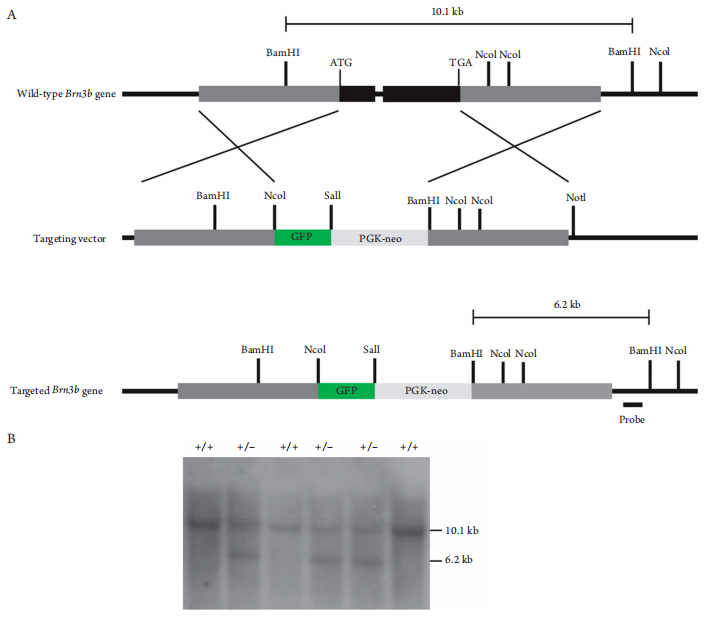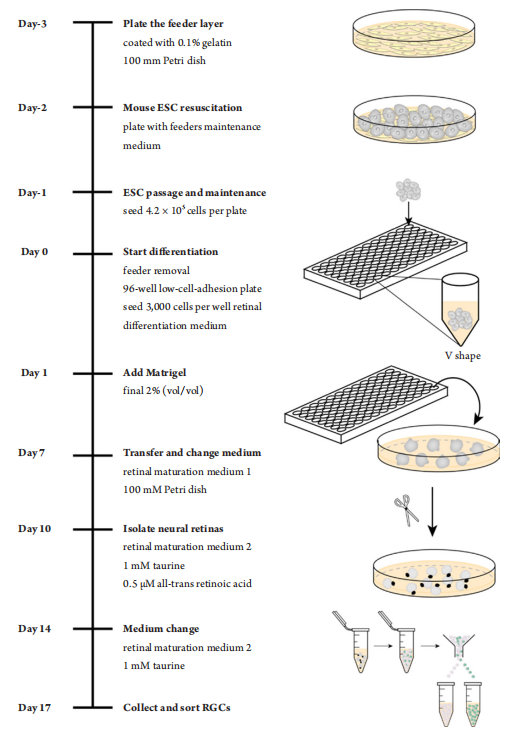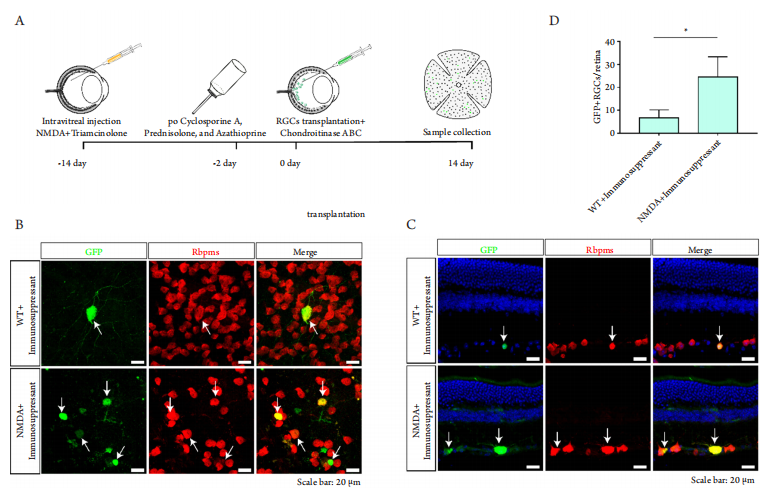1、Laver CRJ, Matsubara JA. Structural divergence of essential triad ribbon synapse proteins among placental mammals—implications for preclinical trials in photoreceptor transplantation therapy[ J]. Exp Eye Res, 2017, 159: 156-167.Laver CRJ, Matsubara JA. Structural divergence of essential triad ribbon synapse proteins among placental mammals—implications for preclinical trials in photoreceptor transplantation therapy[ J]. Exp Eye Res, 2017, 159: 156-167.
2、Mandai M, Fujii M, Hashiguchi T, et al. iPSC-derived retina transplants improve vision in rd1 end-stage retinal-degeneration mice[ J]. Stem Cell Reports, 2017, 8(4): 1112-1113Mandai M, Fujii M, Hashiguchi T, et al. iPSC-derived retina transplants improve vision in rd1 end-stage retinal-degeneration mice[ J]. Stem Cell Reports, 2017, 8(4): 1112-1113
3、Wang J, He X, Meng H, et al. Robust myelination of regenerated axons induced by combined manipulations of GPR17 and microglia[ J]. Neuron, 2020, 108(5): 876-886.Wang J, He X, Meng H, et al. Robust myelination of regenerated axons induced by combined manipulations of GPR17 and microglia[ J]. Neuron, 2020, 108(5): 876-886.
4、Little CW, Castillo B, DiLoreto DA, et al. Transplantation of human fetal retinal pigment epithelium rescues photoreceptor cells from degeneration in the Royal College of Surgeons rat retina[ J]. Invest Ophthalmol Vis Sci, 1996, 37(1): 204-211.Little CW, Castillo B, DiLoreto DA, et al. Transplantation of human fetal retinal pigment epithelium rescues photoreceptor cells from degeneration in the Royal College of Surgeons rat retina[ J]. Invest Ophthalmol Vis Sci, 1996, 37(1): 204-211.
5、Pinilla I, Cuenca N, Sauvé Y, et al. Preservation of outer retina and its synaptic connectivity following subretinal injections of human RPE cells in the Royal College of Surgeons rat[ J]. Exp Eye Res, 2007, 85(3): 381-392.Pinilla I, Cuenca N, Sauvé Y, et al. Preservation of outer retina and its synaptic connectivity following subretinal injections of human RPE cells in the Royal College of Surgeons rat[ J]. Exp Eye Res, 2007, 85(3): 381-392.
6、Sun J, Mandai M, Kamao H, et al. Protective effects of human iPS�derived retinal pigmented epithelial cells in comparison with human mesenchymal stromal cells and human neural stem cells on the degenerating retina in rd1 mice[ J]. Stem Cells, 2015, 33(5): 1543-1553.Sun J, Mandai M, Kamao H, et al. Protective effects of human iPS�derived retinal pigmented epithelial cells in comparison with human mesenchymal stromal cells and human neural stem cells on the degenerating retina in rd1 mice[ J]. Stem Cells, 2015, 33(5): 1543-1553.
7、Jin ZB, Gao ML, Deng WL, et al. Stemming retinal regeneration with pluripotent stem cells[ J]. Prog Retin Eye Res, 2019, 69: 38-56Jin ZB, Gao ML, Deng WL, et al. Stemming retinal regeneration with pluripotent stem cells[ J]. Prog Retin Eye Res, 2019, 69: 38-56
8、Nazari H, Zhang L, Zhu D, et al. Stem cell based therapies for age�related macular degeneration: The promises and the challenges[ J]. Prog Retin Eye Res, 2015, 48: 1-39.Nazari H, Zhang L, Zhu D, et al. Stem cell based therapies for age�related macular degeneration: The promises and the challenges[ J]. Prog Retin Eye Res, 2015, 48: 1-39.
9、Newsome DA , Rodrigues MM, Machemer R . Human massive periretinal proliferation. In v itro characteristics of cellular components[ J]. Arch Ophthalmol, 1981, 99(5): 873-880.Newsome DA , Rodrigues MM, Machemer R . Human massive periretinal proliferation. In v itro characteristics of cellular components[ J]. Arch Ophthalmol, 1981, 99(5): 873-880.
10、Rapaport DH, Rakic P, Yasamura D, et al. Genesis of the retinal pigment epithelium in the macaque monkey[ J]. J Comp Neurol, 1995, 363(3): 359-376.Rapaport DH, Rakic P, Yasamura D, et al. Genesis of the retinal pigment epithelium in the macaque monkey[ J]. J Comp Neurol, 1995, 363(3): 359-376.
11、Schwartz SD, Tan G, Hosseini H, et al. Subretinal transplantation of embryonic stem cell-derived retinal pigment epithelium for the treatment of macular degeneration: an assessment at 4 years[ J]. Invest Ophthalmol Vis Sci, 2016, 57(5): ORSFc1-ORSFc9Schwartz SD, Tan G, Hosseini H, et al. Subretinal transplantation of embryonic stem cell-derived retinal pigment epithelium for the treatment of macular degeneration: an assessment at 4 years[ J]. Invest Ophthalmol Vis Sci, 2016, 57(5): ORSFc1-ORSFc9
12、Salero E, Blenkinsop TA, Corneo B, et al. Adult human RPE can be activated into a multipotent stem cell that produces mesenchymal derivatives[ J]. Cell Stem Cell, 2012, 10(1): 88-95.Salero E, Blenkinsop TA, Corneo B, et al. Adult human RPE can be activated into a multipotent stem cell that produces mesenchymal derivatives[ J]. Cell Stem Cell, 2012, 10(1): 88-95.
13、Davis RJ, Alam NM, Zhao C, et al. The developmental stage of adult human stem cell-derived retinal pigment epithelium cells influences transplant efficacy for vision rescue[ J]. Stem Cell Reports, 2017, 9(1): 42-49.Davis RJ, Alam NM, Zhao C, et al. The developmental stage of adult human stem cell-derived retinal pigment epithelium cells influences transplant efficacy for vision rescue[ J]. Stem Cell Reports, 2017, 9(1): 42-49.
14、Singh RK, Nasonkin IO. Limitations and promise of retinal tissue from human pluripotent stem cells for developing therapies of blindness[ J]. Front Cell Neurosci, 2020, 14: 179.Singh RK, Nasonkin IO. Limitations and promise of retinal tissue from human pluripotent stem cells for developing therapies of blindness[ J]. Front Cell Neurosci, 2020, 14: 179.
15、Souied E, Pulido J, Staurenghi G. Autologous induced stem-cell�derived retinal cells for macular degeneration[ J]. N Engl J Med, 2017, 377(8): 792.Souied E, Pulido J, Staurenghi G. Autologous induced stem-cell�derived retinal cells for macular degeneration[ J]. N Engl J Med, 2017, 377(8): 792.
16、Tezel TH, Del Priore LV, Kaplan HJ. Reengineering of aged Bruch's membrane to enhance retinal pigment epithelium repopulation[ J]. Invest Ophthalmol Vis Sci, 2004, 45(9): 3337-3348.Tezel TH, Del Priore LV, Kaplan HJ. Reengineering of aged Bruch's membrane to enhance retinal pigment epithelium repopulation[ J]. Invest Ophthalmol Vis Sci, 2004, 45(9): 3337-3348.
17、NOELL WK. The impairment of visual cell structure by iodoacetate[ J]. J Cell Comp Physiol, 1952, 40(1): 25-55.NOELL WK. The impairment of visual cell structure by iodoacetate[ J]. J Cell Comp Physiol, 1952, 40(1): 25-55.
18、Fuller D, Machemer R, Knighton RW. Retinal damage produced by intraocular fiber optic light[ J]. Vision Res, 1980, 20(12): 1055-1072.Fuller D, Machemer R, Knighton RW. Retinal damage produced by intraocular fiber optic light[ J]. Vision Res, 1980, 20(12): 1055-1072.
19、Strazzeri JM, Hunter JJ, Masella BD, et al. Focal damage to macaque photoreceptors produces persistent visual loss[ J]. Exp Eye Res, 2014, 119: 88-96.Strazzeri JM, Hunter JJ, Masella BD, et al. Focal damage to macaque photoreceptors produces persistent visual loss[ J]. Exp Eye Res, 2014, 119: 88-96.
20、Gao G, He L, Liu S, et al. Establishment of a rapid lesion-controllable retinal degeneration monkey model for preclinical stem cell therapy[ J]. Cells, 2020, 9(11): 2468.Gao G, He L, Liu S, et al. Establishment of a rapid lesion-controllable retinal degeneration monkey model for preclinical stem cell therapy[ J]. Cells, 2020, 9(11): 2468.
21、Goldstein IM, Ostwald P, Roth S. Nitric oxide: a review of its role in retinal function and disease[ J]. Vision Res, 1996, 36(18): 2979-2994.Goldstein IM, Ostwald P, Roth S. Nitric oxide: a review of its role in retinal function and disease[ J]. Vision Res, 1996, 36(18): 2979-2994.
22、Opatrilova R , Kubatka P, Caprnda M, et al. Nitric oxide in the pathophysiology of retinopathy: evidences from preclinical and clinical researches[ J]. Acta Ophthalmol, 2018, 96(3): 222-231.Opatrilova R , Kubatka P, Caprnda M, et al. Nitric oxide in the pathophysiology of retinopathy: evidences from preclinical and clinical researches[ J]. Acta Ophthalmol, 2018, 96(3): 222-231.
23、Luo Z, Li K , Li K , et al. Establishing a surgical procedure for rhesus epiretinal scaffold implantation with HiPSC-derived retinal progenitors[ J]. Stem Cells Int, 2018, 2018: 9437041.Luo Z, Li K , Li K , et al. Establishing a surgical procedure for rhesus epiretinal scaffold implantation with HiPSC-derived retinal progenitors[ J]. Stem Cells Int, 2018, 2018: 9437041.
24、Becker S, Eastlake K, Jayaram H, et al. Allogeneic transplantation of müller-derived retinal ganglion cells improves retinal function in a feline model of ganglion cell depletion[ J]. Stem Cells Transl Med, 2016, 5(2): 192-205.Becker S, Eastlake K, Jayaram H, et al. Allogeneic transplantation of müller-derived retinal ganglion cells improves retinal function in a feline model of ganglion cell depletion[ J]. Stem Cells Transl Med, 2016, 5(2): 192-205.
25、Matsumoto B, Blanks JC, Ryan SJ. Topographic variations in the rabbit and primate internal limiting membrane[ J]. Invest Ophthalmol Vis Sci, 1984, 25(1): 71-82.Matsumoto B, Blanks JC, Ryan SJ. Topographic variations in the rabbit and primate internal limiting membrane[ J]. Invest Ophthalmol Vis Sci, 1984, 25(1): 71-82.
26、Li K, Zhong X, Yang S, et al. HiPSC-derived retinal ganglion cells grow dendritic arbors and functional axons on a tissue-engineered scaffold[ J]. Acta Biomater, 2017, 54: 117-127.Li K, Zhong X, Yang S, et al. HiPSC-derived retinal ganglion cells grow dendritic arbors and functional axons on a tissue-engineered scaffold[ J]. Acta Biomater, 2017, 54: 117-127.
27、Pearson RA, Barber AC, West EL, et al. Targeted disruption of outer limiting membrane junctional proteins (Crb1 and ZO-1) increases integration of transplanted photoreceptor precursors into the adult wild-type and degenerating retina[ J]. Cell Transplant, 2010, 19(4): 487-503.Pearson RA, Barber AC, West EL, et al. Targeted disruption of outer limiting membrane junctional proteins (Crb1 and ZO-1) increases integration of transplanted photoreceptor precursors into the adult wild-type and degenerating retina[ J]. Cell Transplant, 2010, 19(4): 487-503.
28、Lewis GP, Fisher SK. Up-regulation of glial fibrillary acidic protein in response to retinal injury: its potential role in glial remodeling and a comparison to vimentin expression[ J]. Int Rev Cytol, 2003, 230: 263-290.Lewis GP, Fisher SK. Up-regulation of glial fibrillary acidic protein in response to retinal injury: its potential role in glial remodeling and a comparison to vimentin expression[ J]. Int Rev Cytol, 2003, 230: 263-290.
29、Ivastinovic D, Langmann G, Asslaber M, et al. Distribution of glial fibrillary acidic protein accumulation after retinal tack insertion for intraocular fixation of epiretinal implants[ J]. Acta Ophthalmol, 2012, 90(5): e416-e417.Ivastinovic D, Langmann G, Asslaber M, et al. Distribution of glial fibrillary acidic protein accumulation after retinal tack insertion for intraocular fixation of epiretinal implants[ J]. Acta Ophthalmol, 2012, 90(5): e416-e417.
30、Hippert C, Graca AB, Pearson RA. Gliosis can impede integration following photoreceptor transplantation into the diseased retina[ J]. Adv Exp Med Biol, 2016, 854: 579-585.Hippert C, Graca AB, Pearson RA. Gliosis can impede integration following photoreceptor transplantation into the diseased retina[ J]. Adv Exp Med Biol, 2016, 854: 579-585.
31、Puustj?rvi TJ, Ter?svirta ME. Retinal fixation of traumatic retinal detachment with metallic tacks: a case report with 10 years' follow-up[ J]. Retina, 2001, 21(1): 54-56.Puustj?rvi TJ, Ter?svirta ME. Retinal fixation of traumatic retinal detachment with metallic tacks: a case report with 10 years' follow-up[ J]. Retina, 2001, 21(1): 54-56.
32、Bird AC, Phillips RL, Hageman GS. Geographic atrophy: a histopathological assessment[ J]. JAMA Ophthalmol, 2014, 132(3): 338-345.Bird AC, Phillips RL, Hageman GS. Geographic atrophy: a histopathological assessment[ J]. JAMA Ophthalmol, 2014, 132(3): 338-345.
33、Yang S, Xian B, Li K, et al. Alpha 1-antitrypsin inhibits microglia activation and facilitates the survival of iPSC grafts in hypertension mouse model[ J]. Cell Immunol, 2018, 328: 49-57.Yang S, Xian B, Li K, et al. Alpha 1-antitrypsin inhibits microglia activation and facilitates the survival of iPSC grafts in hypertension mouse model[ J]. Cell Immunol, 2018, 328: 49-57.
34、Sohn EH, Jiao C, Kaalberg E, et al. Allogenic iPSC-derived RPE cell transplants induce immune response in pigs: a pilot study[ J]. Sci Rep, 2015, 5: 11791.Sohn EH, Jiao C, Kaalberg E, et al. Allogenic iPSC-derived RPE cell transplants induce immune response in pigs: a pilot study[ J]. Sci Rep, 2015, 5: 11791.
35、Lai CC, Gouras P, Doi K, et al. Local immunosuppression prolongs survival of RPE xenografts labeled by retroviral gene transfer[ J]. Invest Ophthalmol Vis Sci, 2000, 41(10): 3134-3141.Lai CC, Gouras P, Doi K, et al. Local immunosuppression prolongs survival of RPE xenografts labeled by retroviral gene transfer[ J]. Invest Ophthalmol Vis Sci, 2000, 41(10): 3134-3141.
36、Kiddee W, Trope GE, Sheng L, et al. Intraocular pressure monitoring post intravitreal steroids: a systematic review[ J]. Surv Ophthalmol, 2013, 58(4): 291-310.Kiddee W, Trope GE, Sheng L, et al. Intraocular pressure monitoring post intravitreal steroids: a systematic review[ J]. Surv Ophthalmol, 2013, 58(4): 291-310.
37、Decembrini S, Martin C, Sennlaub F, et al. Cone genesis tracing by the Chrnb4-EGFP mouse line: evidences of cellular material fusion after cone precursor transplantation[ J]. Mol Ther, 2017, 25(3): 634-653.Decembrini S, Martin C, Sennlaub F, et al. Cone genesis tracing by the Chrnb4-EGFP mouse line: evidences of cellular material fusion after cone precursor transplantation[ J]. Mol Ther, 2017, 25(3): 634-653.
38、Ortin-Martinez A, Tsai EL, Nickerson PE, et al. A reinterpretation of cell transplantation: GFP transfer from donor to host photoreceptors[ J]. Stem Cells, 2017, 35(4): 932-939.Ortin-Martinez A, Tsai EL, Nickerson PE, et al. A reinterpretation of cell transplantation: GFP transfer from donor to host photoreceptors[ J]. Stem Cells, 2017, 35(4): 932-939.
39、Liu YV, Sodhi SK, Xue G, et al. Quantifiable in vivo imaging biomarkers of retinal regeneration by photoreceptor cell transplantation[ J]. Transl Vis Sci Technol, 2020, 9(7): 5.Liu YV, Sodhi SK, Xue G, et al. Quantifiable in vivo imaging biomarkers of retinal regeneration by photoreceptor cell transplantation[ J]. Transl Vis Sci Technol, 2020, 9(7): 5.
40、Zhang H, Su B, Jiao L, et al. Transplantation of GMP-grade human iPSC-derived retinal pigment epithelial cells in rodent model: the first pre-clinical study for safety and efficacy in China[ J]. Ann Transl Med, 2021, 9(3): 245.Zhang H, Su B, Jiao L, et al. Transplantation of GMP-grade human iPSC-derived retinal pigment epithelial cells in rodent model: the first pre-clinical study for safety and efficacy in China[ J]. Ann Transl Med, 2021, 9(3): 245.
41、Wiley LA, Burnight ER , DeLuca AP, et al. cGMP production of patient-specific iPSCs and photoreceptor precursor cells to treat retinal degenerative blindness[ J]. Sci Rep, 2016, 6: 30742.Wiley LA, Burnight ER , DeLuca AP, et al. cGMP production of patient-specific iPSCs and photoreceptor precursor cells to treat retinal degenerative blindness[ J]. Sci Rep, 2016, 6: 30742.
42、Uppal G, Milliken A, Lee J, et al. New algorithm for assessing patient suitability for macular translocation surgery[ J]. Clin Exp Ophthalmol, 2007, 35(5): 448-457.Uppal G, Milliken A, Lee J, et al. New algorithm for assessing patient suitability for macular translocation surgery[ J]. Clin Exp Ophthalmol, 2007, 35(5): 448-457.
43、Sullivan S, Stacey GN, Akazawa C, et al. Quality control guidelines for clinical-grade human induced pluripotent stem cell lines[ J]. Regen Med, 2018, 13(7): 859-866.Sullivan S, Stacey GN, Akazawa C, et al. Quality control guidelines for clinical-grade human induced pluripotent stem cell lines[ J]. Regen Med, 2018, 13(7): 859-866.
44、Huang CY, Liu CL, Ting CY, et al. Human iPSC banking: barriers and opportunities[ J]. J Biomed Sci, 2019, 26(1): 87.Huang CY, Liu CL, Ting CY, et al. Human iPSC banking: barriers and opportunities[ J]. J Biomed Sci, 2019, 26(1): 87.







